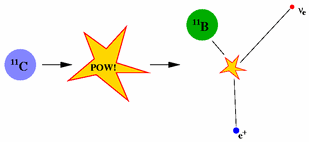|
The reason most people have never heard of neutrinos is because
they pass through most matter like ghosts, only rarely
interacting. Their elusiveness is a result of the fact that
neutrinos are electrically neutral, and so are unaffected by the
electro-magnetic force, and they also do not interact via the
"strong nuclear force". They interact only through the "weak
nuclear force" and gravity, the two weakest of
the four forces. A neutrino can pass straight through the earth
without hitting anything, and they don't pose a health risk to
humans. This is actually pretty lucky for us, because neutrinos are
everywhere around us, zipping past in all directions. If you hold
out your hand, each second over a trillion neutrinos from the sun
pass straight through it! In fact, if you could see each neutrino
as a little black speck flying by, the world would look a lot like
the picture on the right.
|



